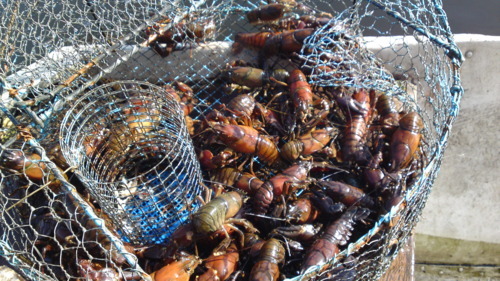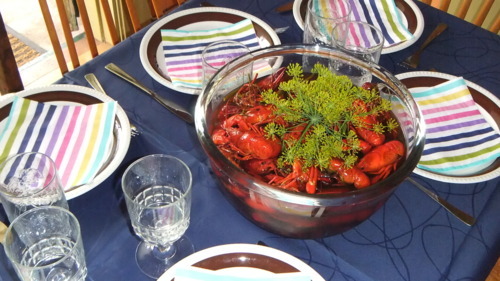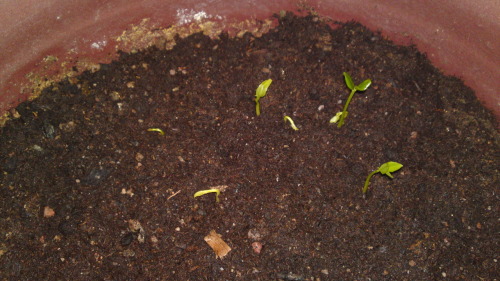Blog Post
Japanese Lunch at Blue Light Yokohama (in Stockholm)
wastholm.tumblr.com/post/10236665881/japanese-lunch-at-blue-light-yokohama-in, posted 2011 by peter in food japan stockholm
Blog Post
Gone Crayfishin'
wastholm.tumblr.com/post/8872442749/gone-crayfishin, posted 2011 by peter in food sweden
I spent last weekend crayfishing in a lake near our family’s summerhouse in the country. We used a new (to us) type of trap, and the catch was better than anything I have ever seen. An example:

We went out twice, setting ten traps each time, and caught around 240 crayfish of legal size, plus at least as many that we had to throw back. Nowadays, crayfish are normally sold by the kilogram, but our relative, who owns the fishing water, is sort of old-school and still sells them by the score (“tjog” in Swedish). With 20 crayfish to a score, he now has twelve score to sell. Swedish crayfish in August are sold at prices approaching or exceeding those of the very finest cuts of meat, and it’s said that it’s a seller’s market this year, so I hope he makes a good deal and I was glad I could help.
Here’s a photo from our vetting procedure. Crayfish of legal size are in the white pails; ones that are to go back in the lake are in the yellow ones. The funny-looking little stick is what we measure them with.

Well, he would have twelve score to sell, except we cooked and ate two score (between five people) later the same day. Swedes cook their crayfish in brine, seasoned with lots of dill and a dash of beer, and eat them cold with bread, cheese and various condiments and side dishes. Crayfish parties are traditionally held in August, usually with liberal amounts of akvavit and other forms of alcohol. Here’s how our crayfish looked when cooked and ready to eat:

We hadn’t really planned on throwing a crayfish party; this was just our little impromptu celebration of a good catch. It’s entirely possible that you have to be a dyed-in-the-wool Swede to enjoy crayfish cooked in this fashion, but I at least thought they were absolutely delicious. There was no akvavit, though, since I was bound to hop on a train and go back home later that same day. Maybe next time.
Bookmark
Would sir like a caesium salad with his steak? « BraveNewClimate
bravenewclimate.com/2011/05/02/would-sir-like-a-caesium-salad-with-his-steak/, posted 2011 by peter in energy food fukushima health japan jpquake science
So, let’s suppose the whole of Japan was covered in caesium-137 to give everybody a dose similar to the helicopter crews flying over the Chernobyl reactor core. Let’s further suppose that there was subsequently a tripling of leukemia rates throughout the whole of Japan.
What are we up to? I’ve postulated a ridiculous worst case scenario over a ridiculously large area causing a rate of leukemia way above anything actually measured. The result would be that leukemia would rise to about 13 cases per 100,000 people per year. This is about half the rate of bowel cancer increase that has afflicted the country as a result of shifting from their traditional diet to one with more red and processed meat. It’s about a third of the male rate of bowel cancer.
Bookmark
Photo gallery: Tsukiji Market, one week on - Time Out Tokyo
www.timeout.jp/en/tokyo/feature/2602/Photo-gallery-Tsukiji-Market-one-week-on, posted 2011 by peter in food japan jpquake msm tokyo
Over in the vegetable section, boxes of fresh tomatoes, daikon, cabbages and citrus fruit are stacked high, awaiting delivery. At the shops surrounding the main market, meanwhile, there's a real abundance of food on sale. The contrast with the 'trapped and starving in post-tsunami Tokyo' stories doing the rounds in tabloid newspapers overseas is pretty striking: if this is scarcity, we'd be interested to know what excess looks like.
Bookmark
Twelve unsustainable things that will soon come to a disastrous end on our planet
www.naturalnews.com/031669_life_on_earth_unsustainable_agriculture.html, posted 2011 by peter in environment food health list nature opinion
If you look around what's really happening in our world today, there's an inescapable pattern that curiously emerges: Much of what's going on is simply unsustainable. It can't go on for much longer, in other words. And it must collapse due to the laws of economics or physics. Here, I've put together a collection of twelve systems that are utterly unsustainable on our planet. Each of these twelve is scheduled for some sort of collapse or shut down in the coming years. They range from economics to medicine, population and the environment. And interestingly, the collapse of just one of these twelve would have devastating consequences across human civilization. What happens when two, three or ten of these things collapse?
Bookmark
Restaurants that charge for miso soup are probably taking you for a ride « The Frugal Feeding Frenzy
https://frugalfeedingfrenzy.wordpress.com/2011/02/28/restaurants-that-charge-for-miso-soup-are-probably-taking-you-for-a-ride/, posted 2011 by peter in food howto japan
I will admit that I am
miso soup ambivalent. The rest of the world though, apparently loves the stuff and my fiancé begged me to figure out how to make it. Challenge accepted.
Thankfully I did not have to look far to find a recipe in JustBento’s . A quick reading revealed that miso soup, like boba, is one of those dishes that are so easy you will kick yourself for paying for them. Even better you can assemble the ingredients ahead of time and bring them along for what I think of as a soup grenade.
Recipe for making miso soup, not quite from scratch, follows.
Bookmark
Ronald McDonald Fades as Chain Touts Lattes, Not Kids Meals - Bloomberg
www.bloomberg.com/news/2011-03-02/ronald-mcdonald-sidelined-as-chain-touts-lattes-not-kids-meals.html, posted 2011 by peter in advertising business drink food health usa
Amid intensifying concern over surging obesity rates, the chain has distanced itself from its fast-food origins, adding café-friendly items such as fruit smoothies and dolling up restaurants with free WiFi and padded seats. While the shift helped to revive sales growth last year -- McDonald’s has credited McCafe coffee for revenue growth in six of the past seven quarters -- the new adults-only ambiance leaves little room for Ronald.
“He kind of represents the old McDonald’s, with the high- fat content foods that are kind of falling out of favor,” said Bob Dorfman, the executive creative director at Baker Street Advertising in San Francisco. “It’s clear that McDonald’s is advertising coffee, they’re not advertising burgers.”
Blog Post
Ten Little Yuzu Plants
wastholm.tumblr.com/post/3523089949/ten-little-yuzu-plants, posted 2011 by peter in food japan nature
Blog Post
Ten Little Yuzu Plants
wastholm.tumblr.com/post/3523089949/ten-little-yuzu-plants, posted 2011 by peter in food japan nature
|< First < Previous 61–70 (104) Next > Last >|



![[photo]](/images/peter_autumn)